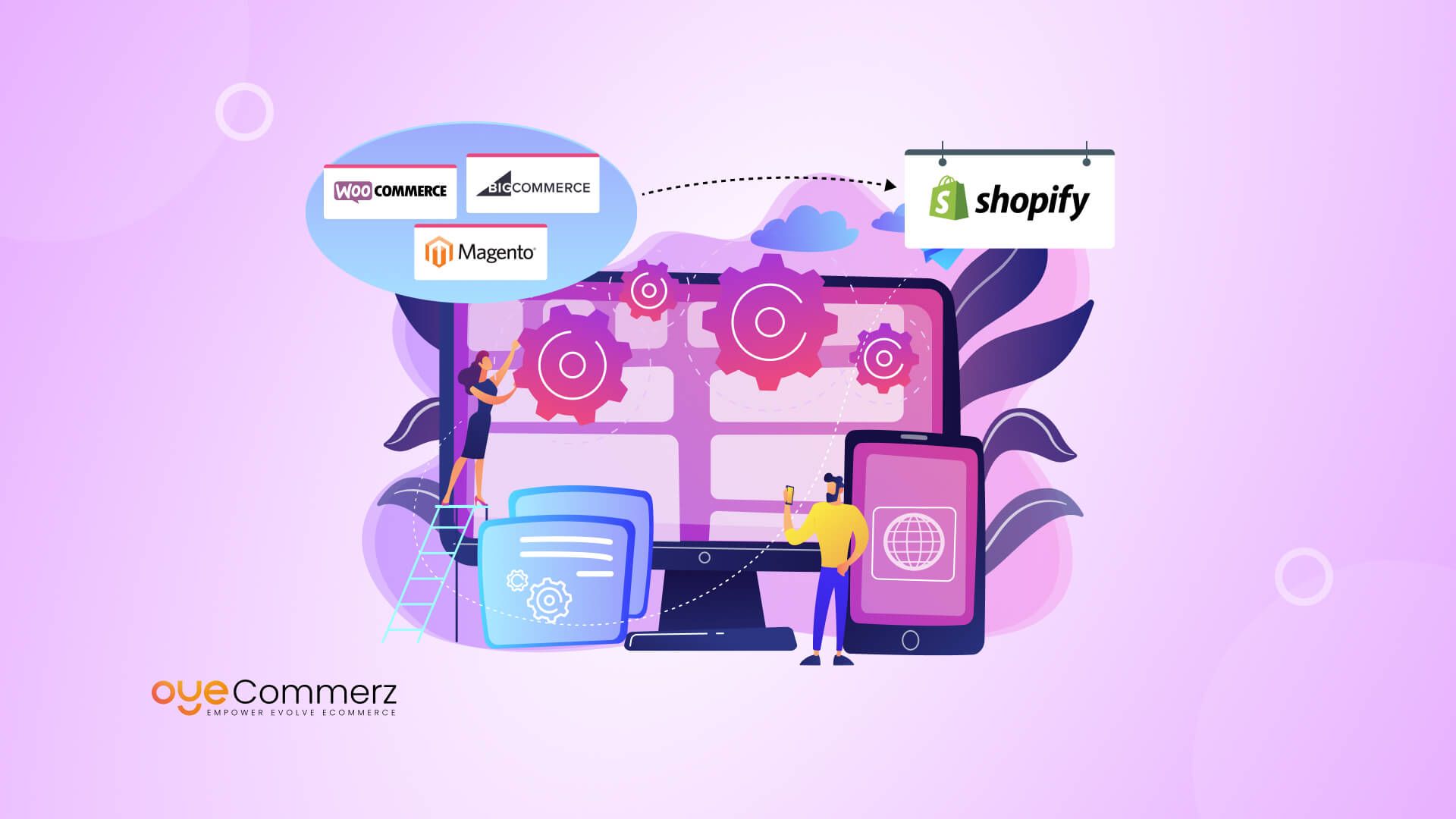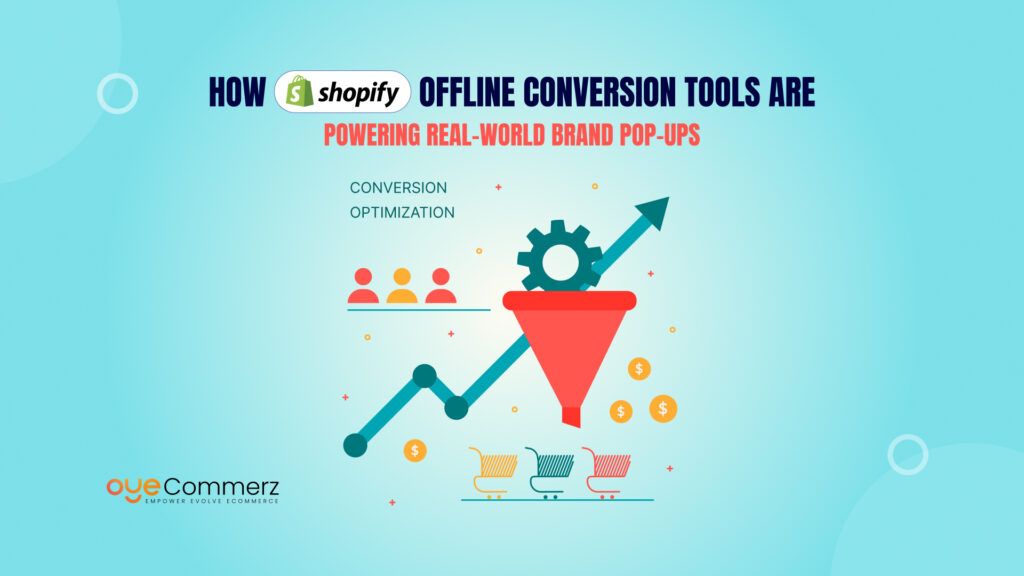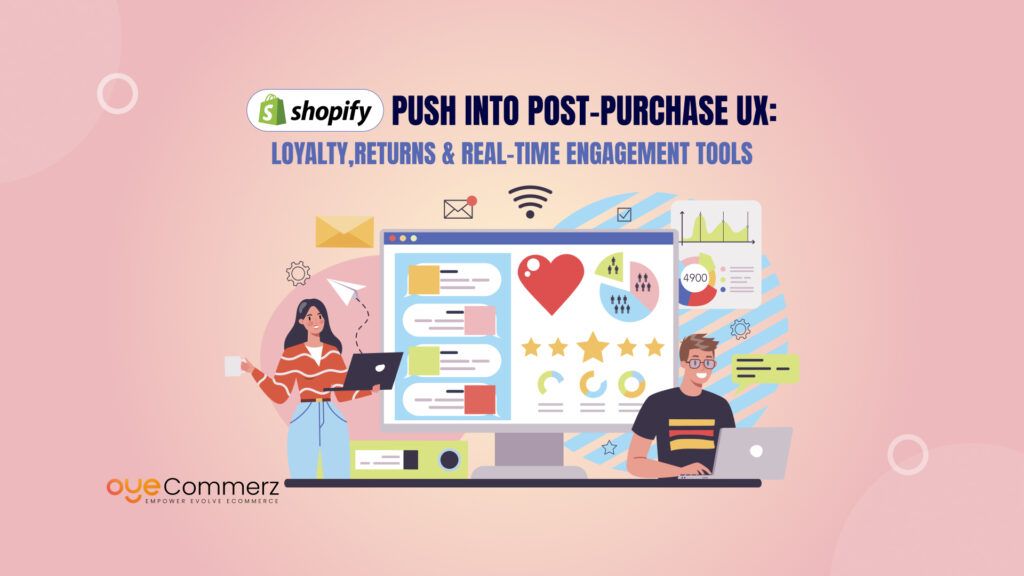Growth within businesses demands proper development of their eCommerce platform. Deciding to replatform from one system to another represents a vital business choice which affects system performance and controls system security such as authentication measures in use.
Large companies continue adopting Shopify in 2025 since it provides businesses with an easy product line coupled with dependable performance and minimal upkeep needs than competing systems including WooCommerce and Magento and BigCommerce.
Managing WooCommerce becomes complex due to its need for constant updates and security patches and many required plugins. A large number of store owners choose Shopify due to its straightforward platform which combines all needed functions into one package.
This write-up investigates the migration of WooCommerce users to Shopify platform solutions yet it includes notes about trends that affect Magento and BigCommerce platforms. Knowing what to do will become easier through this guidance if you plan to relocate.
Table of Contents
ToggleWhy Businesses Are Replatforming in 2025
In the digital world, businesses need eCommerce platforms that are fast, secure, and easy to manage. However, many online store owners are struggling with outdated systems that require too much maintenance, slow down their growth, or don’t meet customer expectations. This is why many businesses are choosing for replatforming in 2025, with Shopify being the most popular choice.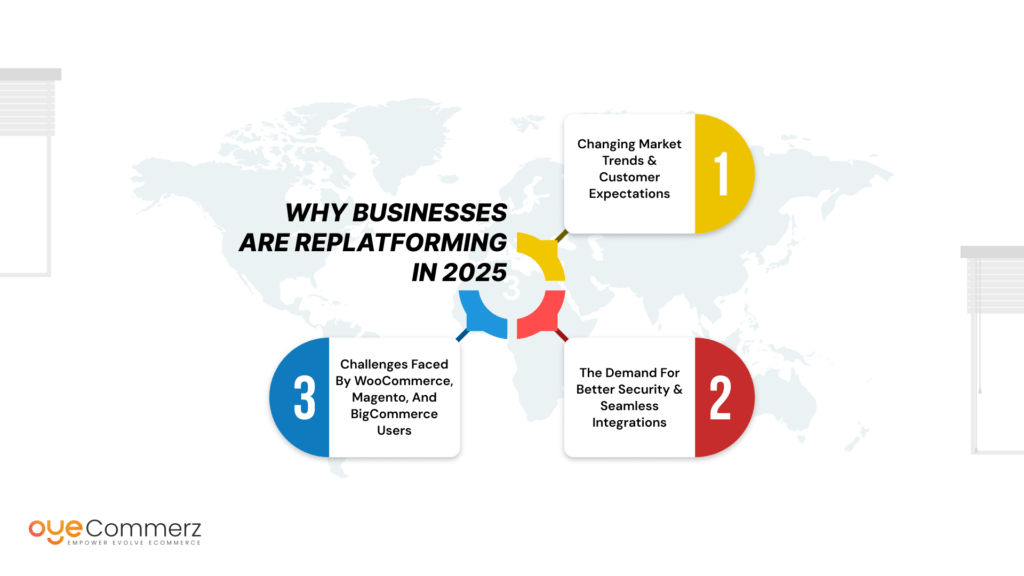
1. Changing Market Trends & Customer Expectations
- Faster Shopping Experience – Customers expect quick-loading websites and smooth checkout processes. A slow or complicated store can lead to lost sales.
- Mobile-First Shopping – More people are shopping on their phones, so eCommerce platforms must be fully mobile-optimized.
- Personalized Shopping Experiences – AI-powered recommendations and data-driven marketing are becoming essential for increasing sales.
2. The Demand for Better Security & Seamless Integrations
- Security Risks – Platforms like WooCommerce require manual updates and extra security measures, while Shopify provides built-in security and PCI compliance to protect customer data.
- Simpler Integrations – Businesses need a platform that works smoothly with payment gateways, marketing tools, and inventory management systems without extra effort.
- Lower Maintenance – Shopify is a fully managed platform, meaning store owners don’t have to worry about hosting, security patches, or software updates.
3. Challenges Faced by WooCommerce, Magento, and BigCommerce Users
- WooCommerce: Requires frequent updates, depends on third-party plugins, and needs technical knowledge to maintain.
- Magento: Complex setup, high development costs, and requires professional help for customization.
- BigCommerce: Higher pricing and limitations on advanced customizations.
Why Shopify?
Shopify provides an all-in-one solution that helps businesses focus on growth instead of managing technical issues. With better speed, security, and integrations, it’s becoming the go-to choice for businesses looking to scale in 2025.
WooCommerce vs. Shopify: Why More Businesses Are Migrating
Many businesses that started with WooCommerce are now switching to Shopify because of its ease of use, better performance, and lower maintenance. Below, we compare the key differences between the two platforms and why Shopify is becoming the preferred choice in 2025.
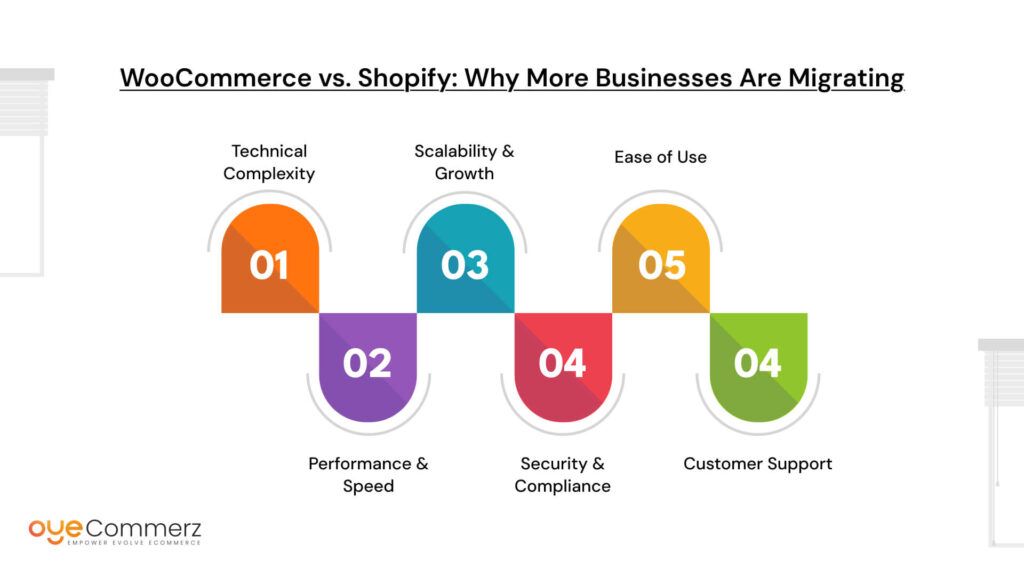
1. Technical Complexity
- WooCommerce: Since WooCommerce is a self-hosted platform, store owners must handle regular maintenance, software updates, plugin compatibility issues, and security patches. This requires technical knowledge or hiring a developer.
- Shopify: Shopify is a fully managed platform, meaning all updates, security patches, and maintenance are handled by Shopify. Store owners don’t have to worry about the technical side and can focus on running their business.
Why It Matters: Businesses prefer Shopify because it eliminates the hassle of managing technical updates, reducing downtime and ensuring a smooth shopping experience.
2. Performance & Speed
- WooCommerce: The speed and performance of a WooCommerce store depend on the quality of the hosting provider. If the hosting is slow or overloaded, the store may experience slow load times, affecting the customer experience and SEO rankings.
- Shopify: Shopify provides high-speed, fully optimized hosting that ensures fast page loading times, even during high-traffic sales events.
Why It Matters: Faster websites improve customer experience, SEO rankings, and conversion rates, making Shopify a better option for businesses that want reliable speed.
3. Scalability & Growth
- WooCommerce: As businesses grow, they may need better hosting, advanced caching, and performance optimization to handle increased traffic. These improvements require extra costs and technical expertise.
- Shopify: Shopify is built for scalability, meaning businesses can handle more traffic, add more products, and expand globally without worrying about performance issues.
Why It Matters: Shopify allows businesses to grow without needing constant upgrades, expensive hosting, or performance tweaks.
4. Security & Compliance
- WooCommerce: Since WooCommerce is a self-hosted platform, store owners must install SSL certificates, set up PCI compliance, and implement security plugins to prevent hacking and fraud.
- Shopify: Shopify comes with built-in security features, including PCI compliance, SSL encryption, and fraud detection to protect customer data and transactions.
Why It Matters: With Shopify, businesses don’t have to worry about security risks, while WooCommerce requires constant monitoring and updates to stay protected.
5. Ease of Use
- WooCommerce: Requires knowledge of WordPress, coding, and plugin management. Setting up a store, managing inventory, and making design changes often require additional tools or developer support.
- Shopify: Offers a drag-and-drop website builder that makes it easy for anyone to create and manage an online store without technical skills.
Why It Matters: Shopify’s user-friendly design saves time and effort, allowing business owners to focus on sales and marketing rather than website maintenance.
6. Customer Support
- WooCommerce: Since WooCommerce is an open-source platform, support is limited to community forums, third-party developers, or paid experts.
- Shopify: Shopify provides 24/7 customer support via chat, phone, and email, ensuring quick resolutions for any issues.
Why It Matters: Reliable support helps businesses avoid long downtimes and technical frustrations, making Shopify a better choice for those who need fast assistance.
While WooCommerce is a flexible option for businesses that prefer full control over their store, it comes with technical challenges, security risks, and performance limitations. Shopify, on the other hand, provides a simpler, more reliable, and scalable solution, making it the preferred platform for businesses in 2025.
Key Factors Driving WooCommerce to Shopify Migrations in 2025
The flexibility and manageability of the Shopify platform makes it more attractive than WooCommerce for efficient eCommerce operations by businesses. Multiple elements push WooCommerce users to shift their platforms to Shopify by 2025 because of AI commerce capabilities combined with mobile-first design and extensive app capabilities and cost-effectiveness improvements. Let’s explore these in detail.
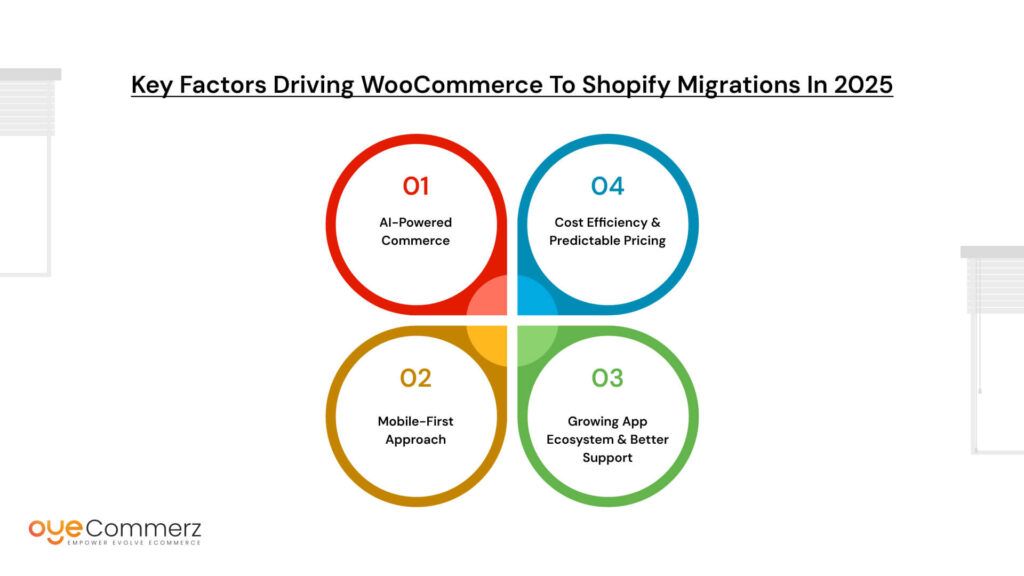
1. AI-Powered Commerce
The eCommerce market receives a transformative impact from Artificial Intelligence because it enables businesses to deliver elevated customer experiences as well as automate tasks and boost sales.
- Shopify implements AI tools under its banner that consist of Shopify Magic which performs automated product descriptions while also generating AI marketing emails and providing customer support through chatbots.
- Shopify uses AI-powered recommendation systems to deliver appropriate products to each individual customer thus maximizing product sales.
- Manual work is decreased through AI as the technology controls inventory management tasks together with order processing operations.
The absence of AI functionality in WooCommerce makes business owners dependent on possibly expensive third-party plugin implementations which can be tough to integrate. Shopify enables its customers to use AI features automatically without requiring extra implementation work.
2. Mobile-First Approach
A successful online store for today depends on mobile optimization because mobile device usage exceeds 70%.
- Shopify provides mobile-optimized themes to the users which automatically optimize their shopfronts for smartphones and tablet devices.
- Shopify operates an infrastructure which delivers rapid speeds to pages that enhances user satisfaction and improves SEO rankings.
- Shopify’s checkout system maintains a basic secure payment process that works efficiently on mobile devices to minimize shopping cart desertions.
WooCommerce users need to perform theme modifications together with additional plugins to create a mobile-friendly website structure yet Shopify includes mobile-ready features automatically.
3. Growing App Ecosystem & Better Support
The strength of an application ecosystem enables businesses to enhance their store capabilities through pre-made programs that do not require programming skills or developer employment.
- The Shopify App Store presents thousands of application options for store enhancement through marketing tools as well as customer service features alongside automation functionalities and analytic solutions. Quality checked applications within the app store allow smooth integration with stores.
- Shopify provides 24/7 live chat together with phone and email support to its customers but WooCommerce depends on outside developers and forums and has limited customer service availability.
- Shopify enables users to easily install and set up applications however WooCommerce users frequently encounter plugin compatibility issues when they handle their updates manually.
Customers who choose Shopify experience improved and time-efficient technical assistance and access to a secure application marketplace thus maintaining a smooth operation with fewer complications.
4. Cost Efficiency & Predictable Pricing
Businesses using WooCommerce need to budget for increasing expenses for hosting services as well as security upkeep and plugin costs after installing the platform for free.
- Shopify provides Predictable Pricing which combines hosting and security features and built-in functionalities into one affordable monthly package.
- WooCommerce incurs several costs since business operators must pay independently for hosting alongside security plugins and premium themes and maintenance expenses. All these fees quickly escalate.
- Shopify maintains complete control over software updates and security enhancements thus saving business time and expenses that WooCommerce owners must handle independently.
The cost management approach of Shopify’s inclusive plans results in WooCommerce owners spending more money than expected on hidden expenses.
Businesses will move to Shopify from WooCommerce during 2025 because the platform offers AI-powered capabilities along with mobile-optimized design and extensive application options and set pricing. Shopify relieves business owners from technical issues so they can concentrate on expansion rather than platform maintenance.
Magento & BigCommerce to Shopify: Other Migration Trends
The trend in 2025 shows that WooCommerce to Shopify migrations dominate while businesses operating with both Magento and BigCommerce are moving their operations. The main factors driving businesses to make this transition involve Magento complexity alongside BigCommerce cost increases and Shopify enhancements for B2B features. Following trends about these changes requires further investigation.
1. Magento’s Development Complexity
Many companies choose Magento as their preferred platform for enterprise solutions yet they migrate to Shopify because its development challenges along with expensive costs become a burdensome factor.
- The implementation of Magento demands costly developer responsibilities which businesses need to pay for installation and maintenance along with handling technical issues. Running B2B features on Magento will eventually lead to significant costs.
- Businesses must constantly update and patch their Magento stores manually to prevent unsecured situations since security updates must be handled promptly.
- Users struggle to manage their online store through Magento due to its complicated customization features which need coding expertise for their implementation.
Businesses choose Shopify over other options since it manages their operations through its automated security features along with scheduled updates and easy-to-use interface which removes daily development tasks.
2. BigCommerce’s Pricing Changes & Limitations
The eCommerce market competitor BigCommerce faces problems from updated pricing structures combined with restricted features that motivate companies to utilize Shopify instead.
- The pricing structure of BigCommerce incites rising payments for businesses when they generate increased annual revenue even though they need not access additional features.
- Businesses face design restrictions because BigCommerce provides themes that require coding expertise and present greater challenges when making design changes.
- Businesses benefit more from the extensive feature-richness of Shopify apps than they would from BigCommerce apps since the Shopify app store provides numerous marketing and engagement tools.
Shopify has become the preferred platform for businesses because it provides clear fixed pricing along with an extensive application marketplace as well as convenient customization options.
3. Shopify’s Improved B2B Features
Shopify has been steadily eclipsing the former B2B-focused platform Magento because it delivers enhanced features that appeal to business users.
- Users can benefit from bespoke pricing together with wholesale catalogues and bulk order handling capabilities in Shopify B2B on Shopify Plus which provides an alternative to Magento B2B solutions.
- The order management capabilities of Shopify present B2B businesses with a straightforward solution which contrasts with the involved technical condition of Magento B2B system.
- The integration capabilities between Shopify and ERP & CRM systems allow B2B sellers to reduce their manual working tasks.
- Shopify provides sophisticated business solutions that simplify Magento’s technical complexity thus enabling B2B companies to operate their stores better.
B2B sellers find Shopify more appealing than Magento and BigCommerce because it offers reduced costs and simpler operation methods and expanded B2B features. Shopify commits to improving its enterprise capabilities which establishes it as the preferred platform for both B2C and B2B commercial sellers.
How to Migrate from WooCommerce to Shopify Without Downtime
A proper transition from WooCommerce to Shopify can happen smoothly by using the correct approach which maintains your existing sales alongside SEO position. The process below will guide you through a move that keeps your operations flowing continuously.
Step 1: Evaluate and Plan the Migration
Go through your WooCommerce store to gather essential information before beginning your transition operation so you can prepare a complete transfer checklist.
- The first step should be to identify all necessary data into separate categories which will be moved during the transition.
- Products must be transferred with their titles, descriptions, prices, images and unique Stock Keeping Units (SKUs).
- Your migration includes all customer-related information which contains their personal names and emails along with their complete ordering record.
- Orders and transaction history
- Blog posts and pages
- Meta tags plus URLs together with redirects form part of the SEO settings.
- Create a Shopify store and select an established password-protected domain for use until you finish the migration process.
The benefits of proper planning include both minimization of mistakes and delivery of a unified transition without any disruptions to your storefront.
Step 2: Export WooCommerce Data
To make your WooCommerce store data usable by Shopify you must perform an export conversion.
- Users can find the CSV export function under WooCommerce → Products → Export which allows a download of the file.
- Perform the export process on customers followed by orders and additional crucial dataset.
- Your large store should use migration applications Cart2Cart or LitExtension to speed up the data transfer process.
- Backups of your entire data become essential at this point because they protect your information during modification.
Step 3: Import Data to Shopify
Move your WooCommerce data to Shopify after you have gathered it.
- To import a WooCommerce store into your Shopify, begin at Settings then select Import Store followed by choosing WooCommerce.
- You can upload CSV data files directly to Shopify or employ Cart2Cart application for automated data transfers.
- Review all imported data to confirm that products with correct information and both customers and orders have imported successfully.
The significance of professional import processes leads to faster data handling with retained information.
Step 4: Choose and Customize a Shopify Theme
The next step consists of designing your store since all the data now resides in Shopify.
- Pick a mobile-friendly Shopify theme from the Shopify Theme Store.
- You must activate your choice of Shopify design features including branding attributes (logo and fonts and colors and layout).
- The Shopify drag-and-drop editor enables you to build essential pages starting with Home followed by About and Contact.
The way a store appears alongside its organization structure determines user experience quality and boosts conversion numbers.
Step 5: Set Up Payment Gateways and Shipping Options
Your Shopify store needs configuration for setting up transaction and order fulfillment processes.
- Payment Gateways: Enable Shopify Payments, PayPal, Stripe, or other providers.
- Perform setup of shipping costs together with tax parameters and delivery area configuration.
- Check the checkout system functionality through a simulated order to ensure payment and shipping functions properly.
The security and easy transaction process which customers look for can be achieved through proper implementation of this step.
Step 6: Test and Optimize Before Launch
A comprehensive inspection of your new Shopify store must occur before its public release.
- Review all products, images, and descriptions.
- The checkout process as well as cart operations and customer account management must undergo testing.
- Your search rankings will stay steady by installing the SEO apps Yoast or Plug in SEO.
- All third-party applications that include email marketing and CRM and analytics should function properly.
The development process of testing detects potential mistakes which are essential to delivering seamless shopping experiences to clients.
Step 7: Redirect URLs to Maintain SEO Rankings
Your SEO ranking stability and organic website visitors depend on establishing 301 redirects for all your former WooCommerce page URLs.
- Go to Online Store → Navigation → URL Redirects in Shopify.
- You must implement 301 redirects which will send users from expired WooCommerce web pages to their new corresponding Shopify locations.
- Update Google Search Console and sitemap with your new Shopify URLs.
The importance of redirecting depends on three key aspects: it enables broken link prevention and preserves SEO value as well as delivering uninterrupted customer experiences.
Make the Switch to Shopify Today!
Ready to migrate from WooCommerce to Shopify? Oyecommerz ensures a seamless transition with no downtime, helping you grow your eCommerce business effortlessly. Let our experts handle the migration so you can focus on what matters.
Start now! Book your free consultation today!
Ready to Migrate to Shopify ? Let Us Help You Make the Switch!
Conclusion
Shopify demonstrates itself as the ideal platform for companies that want to transition away from WooCommerce during 2025. Shopify provides businesses of any size with a full eCommerce platform through its interface which is easy to use along with built-in security protocols as well as seamless scalability and AI-based tools.
Woocommerce to Shopify Migration Services provides WooCommerce users with eliminating technical struggles alongside better site speed and improved shopping convenience alongside higher operational efficiency. Users who encounter maintenance expenses and slow page loading and want more functionality should consider switching to Shopify because it delivers a straightforward alternative solution.
Frequently Asked Questions
In 2025, businesses are replatforming to Shopify due to its improved performance, ease of use, faster deployment, and extensive ecosystem of apps and integrations. Shopify’s scalability, built-in security, and focus on headless commerce make it an attractive option for brands looking to future-proof their online stores.
Yes, Shopify has emerged as a preferred platform in 2025 for many businesses due to its low maintenance, faster page speed, and seamless multichannel integrations. Compared to WooCommerce, Magento, and BigCommerce, Shopify offers better ROI with a more intuitive backend and enhanced customer support.
WooCommerce remains viable for smaller websites, but many mid-to-large-scale businesses are migrating to Shopify in 2025 for better scalability, uptime reliability, and built-in eCommerce features. Shopify’s integrated approach saves time and development effort, making it a more competitive option in today’s market.
Migrating from BigCommerce to Shopify in 2025 has become easier with automated tools, expert migration services, and Shopify’s detailed documentation. Businesses can transfer products, customers, and order history with minimal downtime while maintaining SEO rankings and store performance.
Before replatforming to Shopify in 2025, businesses should evaluate their store’s size, required features, integrations, and long-term growth plans. While Shopify offers excellent flexibility and performance, planning for design, SEO, and data migration is crucial for a smooth transition.

